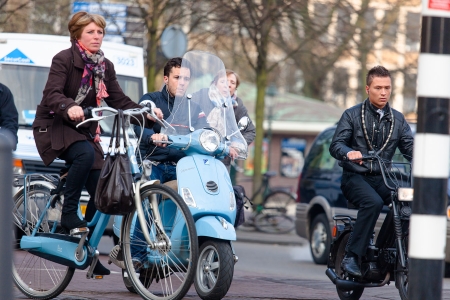Below, the most frequent crash factors are discussed, classified under behaviour, vehicle, road. These crash factors originate from a Dutch in-depth study of light-moped crashes [3] and a Danish analysis of police files [4] of light-moped crashes with 16 and 17 year-old riders.
Behaviour
In both the Dutch and Danish study behavioural factors were found to be the most common crash factors. In the Dutch study, from the perspective of the light-moped rider, the behaviour of another road user was the most common factor (69-72% of the studied crashes)[i]. In most cases this involved failure to give priority to the light-moped rider. The behaviour of the light-moped rider also plays an important role in causing crashes. The top 5 of human factors is:
- speed above the limit or too fast for the conditions (19-28%);
- internal conditioning, such as narrow focus or "I have priority" (14-25%);
- psychophysiological condition, such as hurry, tired, alcohol (11-17%);
- unfamiliar/inexperienced with situation or vehicle (8-17%); and
- position on the cycle path (8-14%).
The factors that most frequently played a role in the development of the studied crashes from the perspective of the other road user (the crash opponent) are the limited view on other traffic (30-37%), the layout of the intersection (26-37%), the position of his vehicle (30-33%) and the behaviour of the light-moped rider that forces him to act (22%).
The Danish analysis also mentioned attention (including distraction, 'failed to look' and 'narrow focus') as common behavioural factors [4].
Vehicle
Three vehicle factors play an important role in the safety of (light-)mopeds. First, (light-)mopeds as vehicle offer no protection in the event of a crash; that is why the (light-)moped rider as well as the cyclist and motorcyclist is a vulnerable road user. Second, (light-)mopeds are equilibrium vehicles, which makes the vehicle control more demanding; the better the vehicle control, the better the attention that is available to anticipate and ride safely [5]. Third, it is relatively easy to tune up (light-)mopeds. This is partly because many (light-)mopeds are constructed with a potentially high engine power after which a speed restriction is added for the sale to countries such as the Netherlands where a low speed limit applies [6]. The Dutch in-depth study of (light-)moped crashes also indicates that, in addition to a 'bad state of the tires or brakes of the (light-)moped' (8-14%), a 'tuned up vehicle' (6-17%) is also a common vehicle factor.
Road
The most common infrastructure- or environment-related factors in the Dutch in-depth study were: 1) view on other traffic is limited by trees, parked cars or other objects (19-25%); 2) wet/damp road surface (14-19%); and 3) sub-optimal intersection layout, such as a non-conflict-free setting of the traffic lights or too small a positioning space before the bike path for vehicles turning off (14-17%) [3]. In the Danish analysis of police files similar-related crash factors were found; however, they played less often a role [4]. This may be due to the dependence of police data and the extent to which the police pay attention to the role of the infrastructure in the occurrence of crashes.
[i] The first (and lowest) number in parentheses indicates in how many percent of the crashes the crash factor has (almost) certainly played a role. The second percentage also includes the crashes in which there was some doubt on the validity of that factor.
